By Mariana Mora / @rataquerueda and María Quinn / @mariaquinnc
Photos by Mariana Mora / Infographics by María Quinn
Translation by Scott Powell
Faced with a public health crisis due to kidney disease in the region, a group of women organized in Agua Caliente – on the shores of Mexico’s largest lake, Chapala, in the municipality of Poncitlán, Jalisco – to launch a community garden of medicinal plants. Although there are factors beyond their control, these women are counting on their collective organization around a budding agroecology project, to help them care for their health.
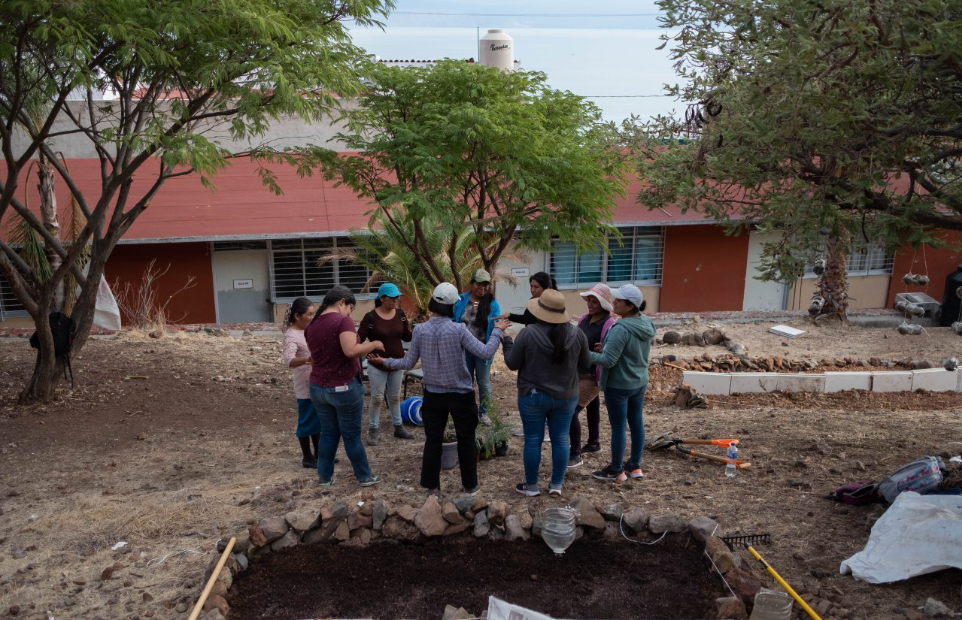
A group of women and girls stand in a circle. The assignment is to pass energy through hands that do not touch. Their eyes are closed, and each one must imagine herself as part of the garden they are creating. Some said they were the water. Others imagined themselves as the water tank, because in an orchard it is important to have water accumulated and contained for irrigation.
Gregoria de Jesús Díaz, a short woman with a warm smile, said she imagined herself to be the earth because “we are upon it”, even though it is malnourished, just like their bodies. To this, Flor López Sánchez, an agronomist from the Escuelita Benita Galeana, replied that, like her body, the earth can be nourished, and that is why they are here.
It is May 2023, and the women are gathered at the Agua Caliente middle school to start a community composting process, using organic waste from their homes, to feed the soil in their garden. This project began three years ago, when Gregoria de Jesús Díaz — Goya, as everyone calls her — and her friends identified in a community diagnosis that one of their most urgent needs was to attend to the community’s health.
The municipality of Poncitlán, where Agua Caliente is located, has attracted public attention due to the high prevalence of kidney disease and other chronic degenerative diseases in its population. At the national level, the Ministry of Health reported in 2021 a death rate from chronic kidney disease of 10.9 per 100,000 inhabitants. In Poncitlán, according to its civil registry, the rate is 20.01, from 2010 to the present. Almost double.
The municipal authorities of Poncitlán did not provide data for each year, which makes it difficult to know the progression of the public health crisis. In addition, according to the state registry of Chronic Renal Patients, the records of sick people in Poncitlán represent 3.13% of the total across Jalisco state; however, the population of Poncitlán constitutes only 0.64% of the state.
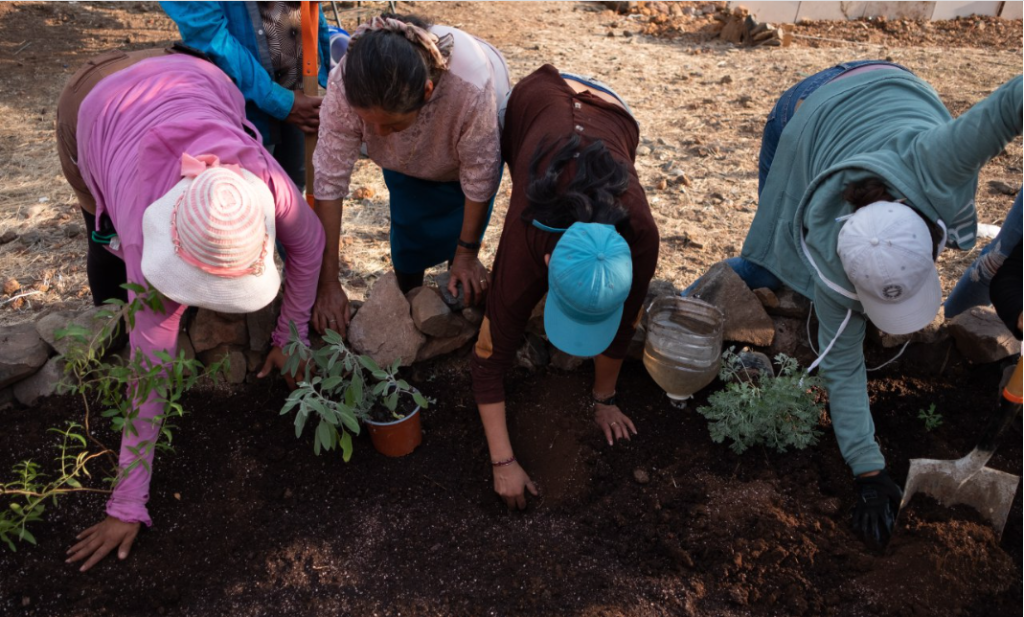
To this day, the medical, scientific, and political consensus on the causes is opaque and officials resort to multi-causality as a way of not pointing out a single factor on which action could be taken.
Among the multiple factors that explain this health situation, food is where the women have the greatest likelihood of having an impact. Other factors have to do with pollution, poverty, and water insecurity. For this reason, the idea of an organic garden of medicinal plants proposed by the women of the Escuelita Benita Galeana resonated as a way of self-managing their health.
“Well, it was through Gregoria that we got to know people from the school,” explains Dulce de Jesús Díaz, Goya’s younger sister, sitting in her kitchen surrounded by her other sisters. Behind her, over the wood stove, hang utensils blackened by soot. Between her feet, a dozen chicks scratch for kernels of corn. The five sisters tell of the process of building an alternative to the problems affecting their community.
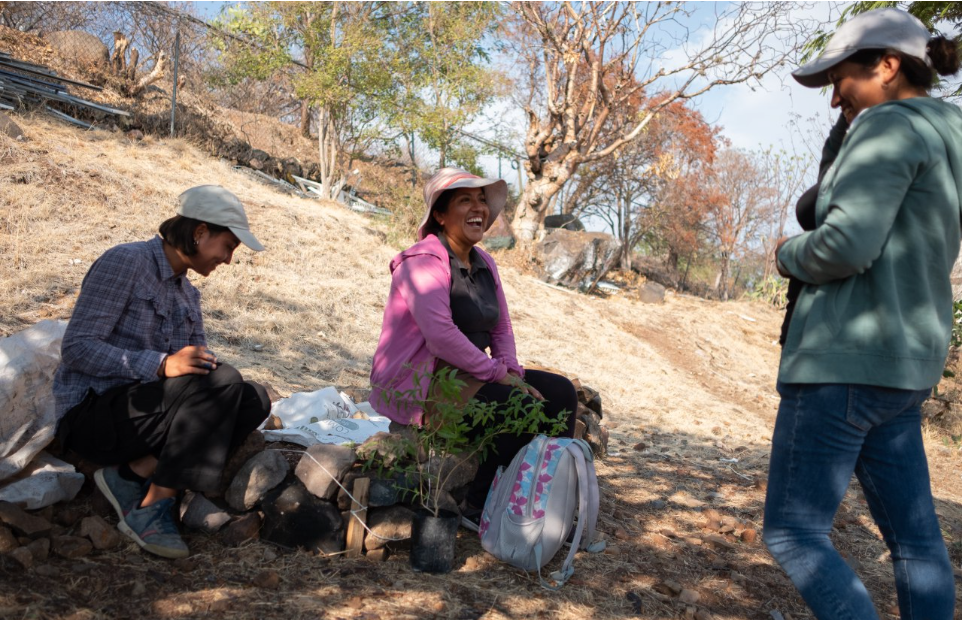
The Escuelita (Little School) Benita Galeana for Women Defenders is an ecofeminist popular education project created by seven women in 2015, for policy and leadership training of women in rural areas of Jalisco. Since then they have worked in 17 municipalities of the state, bringing knowledge of agroecology and ecotechnologies to the communities, in accordance with the needs and desires expressed. They also have a small social solidarity market where the products of the people they work with are sold. In 2017 they formed the Network of Women Defenders of Jalisco, to fight for the health of their bodies and their lands.
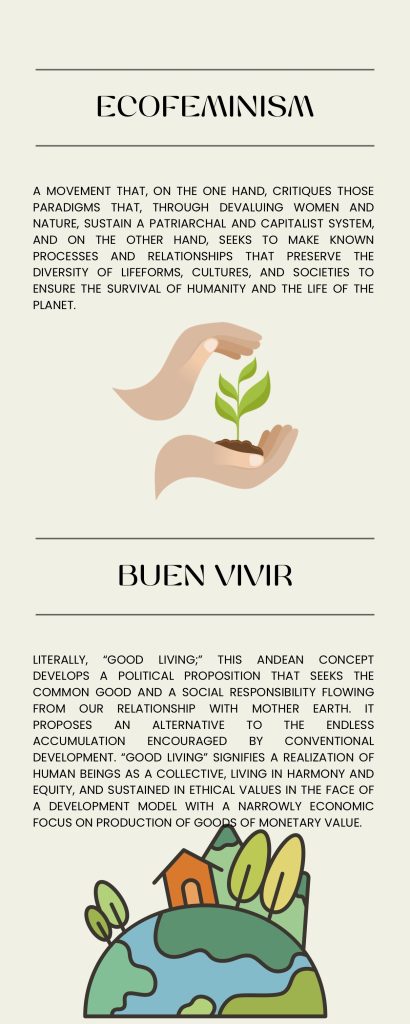
In 2020 they approached the women of Agua Caliente to ask how they could help. Carmen García — co-founder of the Escuelita — remembers that her response was that they were worried about their health, and that they did not know why they were getting sick. First, they gave health and nutrition workshops and, little by little, they developed the idea that they themselves could contribute to the well-being of their families by planting an agroecological garden of medicinal plants. “The women were coming together and strengthening themselves,” as Carmen tells it.
Water insecurity on the shores of the largest lake in Mexico
Agua Caliente is part of the municipality of Poncitlán and is on the northeast edge of Lake Chapala, the largest lake in Mexico and one of the largest in Latin America. It is a small community: the 2020 census of the National Institute of Statistics and Geography (INEGI) records 1,284 inhabitants, which represents 2.3% of the municipality. Agua Caliente is essentially a narrow, steep, and winding street, recently paved, that goes down from the hill to the lake. The census records 157 households, where an average of 8.2 people live per house.
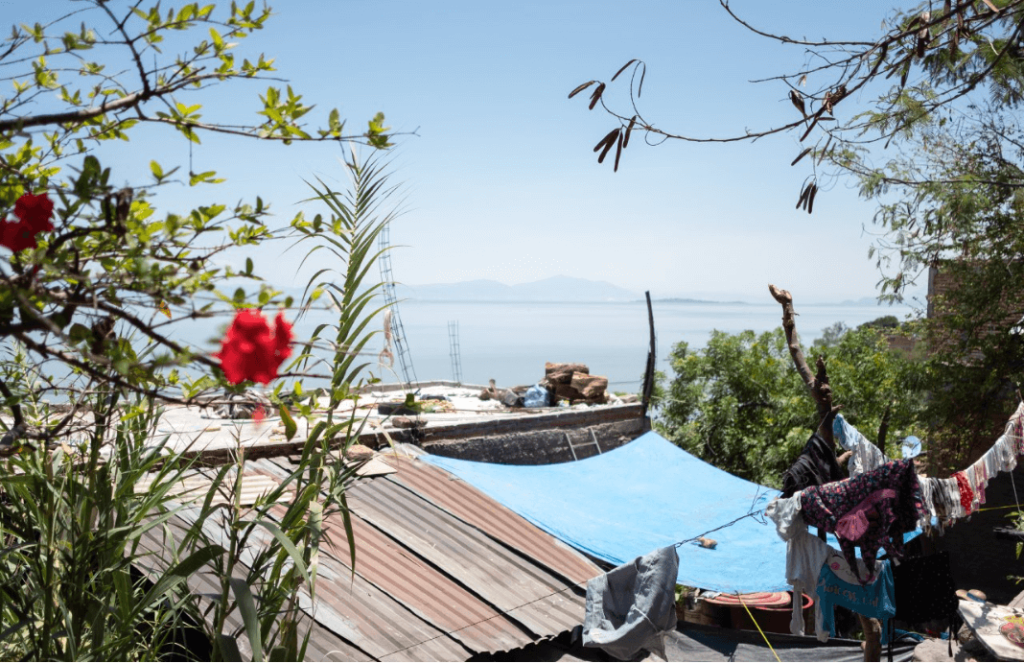
Despite living on the edge of a body of water that supplies 65% of the metropolitan area of Guadalajara – the second largest city in Mexico – the population of Agua Caliente does not have guaranteed access to water of sufficient quality and quantity. According to an information sheet on Lake Chapala, prepared in 2021 by the environmental organization Instituto Corazón de la Tierra, the lake is highly contaminated by heavy metals – arsenic, copper, chromium and zinc. These come from companies established across the Bajío Corridor, such as leather production in Guanajuato and the petrochemical plant in Salamanca, as well as other industrial activities in the upper part of the Lerma-Santiago basin, in the highlands of Jalisco, Toluca, and Querétaro.
“All of Chapala, the largest lake in Mexico, is a fecal coliform sewer,” says engineer Ana Sofía Macías, who has investigated the quality of Chapala’s water, due to organic waste from municipal discharges. In addition, there is an excess of nutrients such as phosphorus and nitrogen, due to run-off from agro-fertilizers, municipal sewage, waste from pig farms, and discharges from the tequila industry.
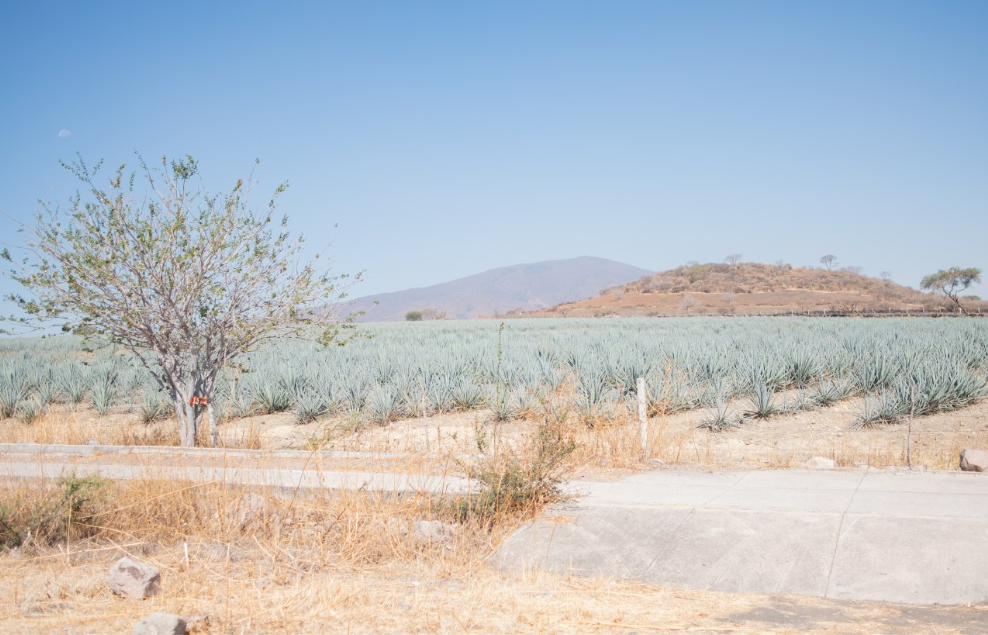
This has made it unsafe to consume water directly from the lake, as shoreside communities had done for centuries. In addition, the 2021 National Health and Nutrition Survey (ENSANUT) states that in the “Pacific-Central” region, where Jalisco is located, 19.8% of households have water insecurity; that is, in one in five households there is an inability to access and benefit from adequate, reliable, and safe water for well-being and a healthy life.
“Water insecurity has detrimental impacts on people’s mental, nutritional, and physical health, as well as on the economic and political well-being of countries; however, the extent of the damage has not been sufficiently documented,” the survey states. In Agua Caliente, only two-thirds of the houses are connected to the public water system, and for many years they obtained water from a well tapping into thermal waters, which increases the risk of consuming higher concentrations of heavy metals.
The garden had to be suspended until the arrival of the rains, since there was no water to water the plants. At the beginning of July, when they began to transplant, they had gone almost a week without water flowing from the public system in the houses of Agua Caliente, where only a third of them have a water tank or cistern that allows them to be prepared for failures in the supply. Given these conditions, it is not unusual for people in the community to use water directly from the lake, without going through some type of treatment that removes at least part of the contaminants.
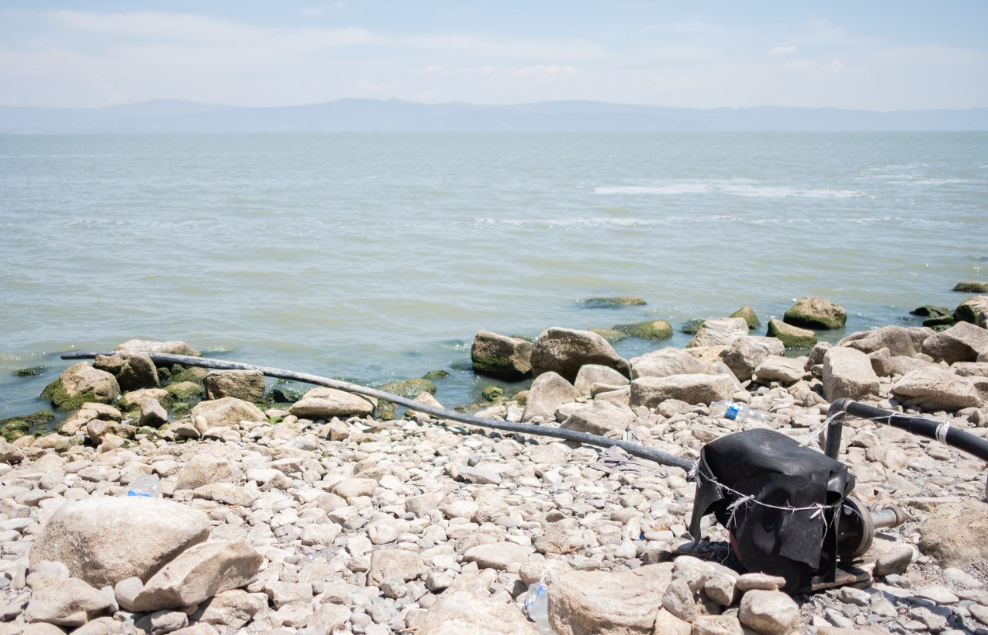
Difficult access to health services
The Agua Caliente health center is a low-rise, two-room building with ceramic floors, two desks, a few chairs, and white walls hung with informational posters. It only operates on Monday and Thursday mornings and has not had a doctor for more than two months. “There is supposed to be a replacement at any time,” explains Iván Salgado, the health promoter who, along with a nurse, attends the place. “I hope it doesn’t take long,” he adds anxiously.
Normally, it provides the services of any first-level care center: detection and follow-up of some diseases and administering vaccines; but without a doctor, the nurse can only perform some of these services. For his part, the promoter does prevention work that is focused on providing information through workshops and campaigns. If a person is diagnosed with a disease, they are referred to second or third level health centers in Poncitlán or other neighboring municipalities, including Guadalajara.
The medical unit of the Mexican Institute of Social Security (IMSS) in Poncitlán – the closest — is located 11 kilometers from Agua Caliente, about 20 minutes by car. To get there, you can take a truck that passes twice a day or wait for someone from the community with their own car to go there. If one had to go to Guadalajara, it would take her an hour and a half to travel before being attended. Some 70% of the homes do not have a private car, truck, or motorcycle.
Neither the De Jesús Díaz sisters nor their husbands have social security through IMSS. According to the Institute of Statistical Information and Geography of Jalisco (IIEG), only 56 people in the community have IMSS, and 880 are affiliated with the Institute of Health for Wellbeing (INSABI), which is the health agency for non-beneficiaries of other public institutions. For the most part, men are dedicated to construction and women to domestic work, both outside of Agua Caliente, and their employers rarely enroll them in the IMSS. Therefore, when they have a health problem, the sisters go to a private doctor.
In Mexico, most people choose this option as well. The 2021 ENSANUT shows that 25% seek medical care in private offices, followed by 24% who receive care at the IMSS and 18% in offices adjacent to pharmacies.
Given this scenario in which access to medical care is difficult, prevention and self-management play a fundamental role in the health of the population of Agua Caliente. Although the work of the health promoter seeks to fulfill this function, the women say that they did not learn in depth about nutrition with the tools that they were given. Educators talked to them about a “menu of good eating,” but they did not address other health teachings they have had with the Escuelita, such as the effects of sausages or the consumption of sweeteners. They also say that the health center recommends foods that they cannot access. “They only eat that in the city,” says Carmen de Jesús Díaz, another of Goya’s sisters.
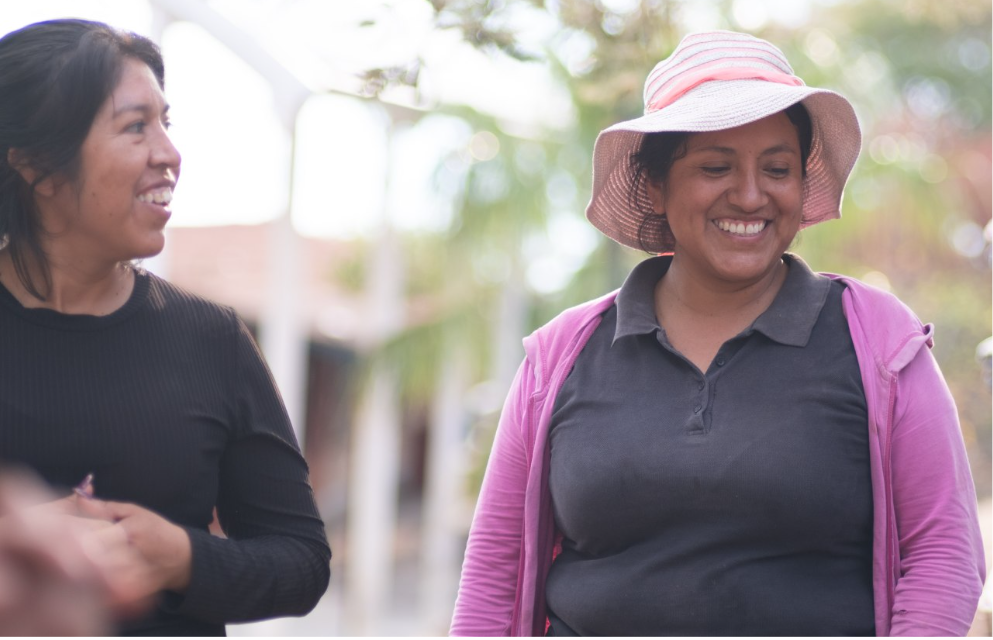
The arrival of diagnoses and uncertainty
Although the causes are blurred, the experience of kidney disease is part of the daily reality of people in the communities on the shores of Lake Chapala. When Dr. Felipe de Jesús Lozano Kasten, a doctor and researcher at the University of Guadalajara, began conducting studies on the boys and girls of Agua Caliente to detect early signs of kidney disease, he was received with suspicion and skepticism by the community.
The sisters remember little of the first visits of the researchers from the multidisciplinary team of the University of Guadalajara, and when remembering they look for temporal references in the dead and sick of the region.
“He began to come when Mary’s child was sick, right? Or was it before? Who was the first patient?” Carmen asks to determine precisely if they had arrived in 2016 or 2017. They argue about who was the first to die from kidney disease.
At first, the sisters did not get involved when the doctors arrived from Guadalajara. There were no symptoms of the disease in their family, and they were busy with other things. But in one of the studies, Goya’s four children appeared on the list of those with a problem. “I didn’t wait for the answer — for what they were going to tell me. I ran out of the place,” says Goya. She left the school crying, heading home.
“I thought: I can’t believe it. I have made the effort to ensure that my children eat, more or less. Maybe not the best, but limiting them to certain things and feeding them at regular times. How can this be?”
Through her tears, she explained to her husband what was happening. He simply replied that it was not true. The women’s husbands have told them that the doctors are crazy or are interns and don’t really know what they are doing.
The anguish that perhaps all of her children could develop chronic kidney disease, and the lack of information about its causes, made Goya worry more about her children’s diet and limit their consumption of junk food and ultra-processed food. She also made the decision not to authorize further studies to be carried out on her children during Dr. Lozano Kasten’s visits. There was no dialogue with the parents that would allow them to better understand the situation.
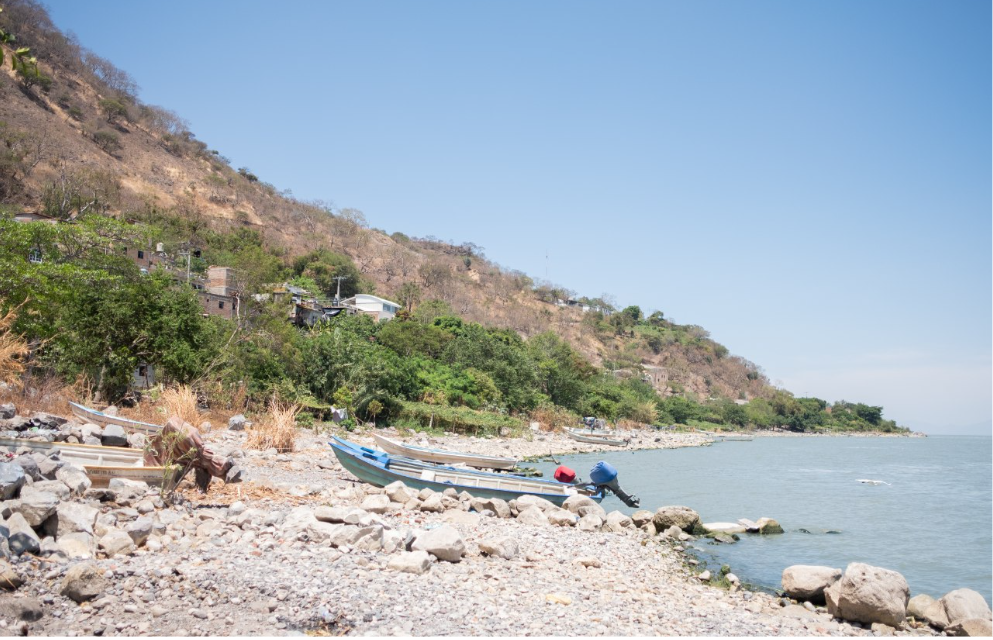
The role of diet in diseases
Among the causes of the high rate of kidney disease in the area, researchers have pointed most insistently to malnutrition of the population. In the book “Social exclusion in childhood and kidney disease in Lake Chapala,” which compiles the work of fifteen researchers who study the problem, the feeding of children in Agua Caliente “with nutritional deficiencies” is described.
The food situation in Agua Caliente is common in places with similar characteristics. According to the 2021 ENSANUT, in rural populations with less than 2,500 inhabitants, 39.7% of households have food insecurity, while only 29% have food security. The latter is defined as none of the household members having to sacrifice the quality or quantity of the food they usually consume and not having to skip meal times or stop eating for a full day. However, the presence of kidney disease is not as high in other populations that live with food insecurity as it is in the communities of Poncitlán that live on the shores of Lake Chapala.
Goya and her sisters recognize that eating habits in Agua Caliente are not the best, but they can also easily chart how they have changed and why.
“From what my sisters say, the food was better before,” explains Dulce, the youngest. The others add their childhood memories: they ate beans from the pot, cooked nopales and fish broth. They ate corn atole every morning and did not consume bottled sauces because “there was always a molcajete with chili.” They consumed the eggs from their mother’s chicken and drank the milk from the cows they milked.
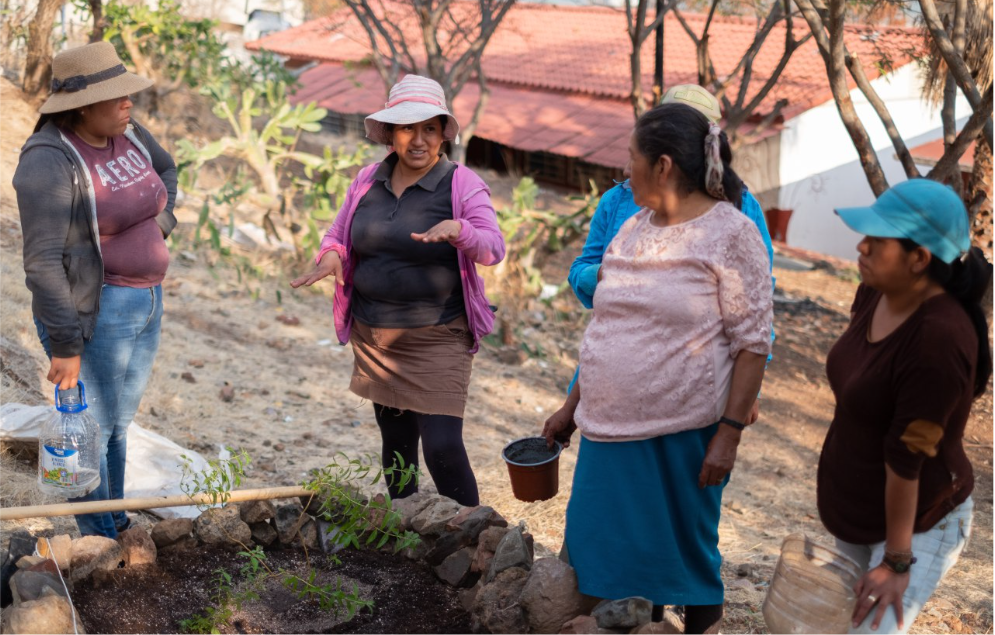
In addition to growing corn, beans, and chayote, their father fished in the lake. Gregoria remembers that, before, it was common to go to the shore and ask the fishermen to give them a fish, but that practice began to disappear around 2010. Goya’s brothers did not follow in their father’s footsteps, and instead of fishing, they went to work as bricklayers in the city.
They also remember the presence of soft drinks in the community since the 1990s and the gradual arrival of other industrialized foods such as dairy products, sausages, cookies, chips, mayonnaise, pasta, canned tuna and sardines. With the departure of men to work outside the community, and even to migrate to the United States, people began to have more money and to buy more food in stores.

Currently, beans, eggs, cactus, and corn are still consumed in the community as central elements of the diet, but the consumption of soft drinks and junk-food has also increased. Although it is documented that the latter have harmful effects on health, their consumption in Agua Caliente is not enough to explain the high presence of kidney disease, as it is similar to the national average. The 2021 ENSANUT indicates that 87% of the population aged 1 to 4 years consume sweetened drinks and 53% eat snacks. For children ages 5 to 11, the proportion that consumed sweetened beverages was 92.9%, and 50% consumed sweet snacks and desserts.
Understanding the role of diet in the incidence of kidney disease has been a double-edged sword for communities experiencing this health crisis. On the one hand, it leaves the entire weight of responsibility on their eating habits and minimizes other structural causes and responsibilities that fall on careless authorities and lazy companies. On the other hand, food is an aspect of their lives in which populations can exert resistance, although it implies a titanic effort to correct inequalities.
Agrotoxics, the green revolution, and transformations in planting in the Mexican countryside
In addition to eating habits, researchers trying to understand the health problem have focused attention on the presence of pesticides in the blood and urine of people in shoreside communities. However, these investigations focus on subsistence crops grown by the people and leave agribusiness in the background in their responsibility for the presence of these substances in water, soil, fish, and food.
In the book “Social exclusion in childhood and kidney disease in Lake Chapala”, the only article that studies exposure to pesticides documents their use by the community. Although this information may be useful to the population to recognize the way in which these substances remain in their bodies, it makes invisible the broader agroindustrial context in which these communities are immersed. There is no study that investigates the substances used in the crops of transnational companies installed in the basin and their effects on the health of the population.
In one of the studies conducted by Dr. Lozano Kasten, published in 2021, he found that all the children analyzed had glyphosate in their urine, regardless of their age. Glyphosate is an herbicide that the World Health Organization (WHO) classified as “probably carcinogenic” and is used to eliminate weeds in controlled crops. The investigation found higher levels of the substance in May, when the land is prepared for cultivation. However, glyphosate was also found in the urine of children who did not come into direct contact with it.

In addition to widespread use of glyphosate on crops, in 2008 an aquatic weed control program implemented by the State Water Commission (CEA) began using it to eliminate the presence of lily in Lake Chapala. For eight years, glyphosate was directly discharged into the water.
In a study by the Heart of the Earth Institute in 2013, “the use of seven main fertilizers was identified, as well as 18 active substances of herbicides and 23 of pesticides. It is important to note the presence of compounds with a high degree of toxicity.”
These substances are applied to crops but end up in lake water through soil loss and runoff. “Agricultural and livestock activities are those that occupy the largest surface area of the basin and, therefore, those that have had the greatest impact.”
Jalisco is divided into eight farming districts, and in each one different products are planted. In the district of La Barca — where Poncitlán and other municipalities on the shores of Lake Chapala are located — 6,681 hectares (16,509 acres) of raspberries were planted in 2022. This figure represents a quarter of the planting of this fruit in the entire country. In 2005, 145 hectares were planted. Thus in 17 years, raspberry production in this region increased by more than 1,500%.
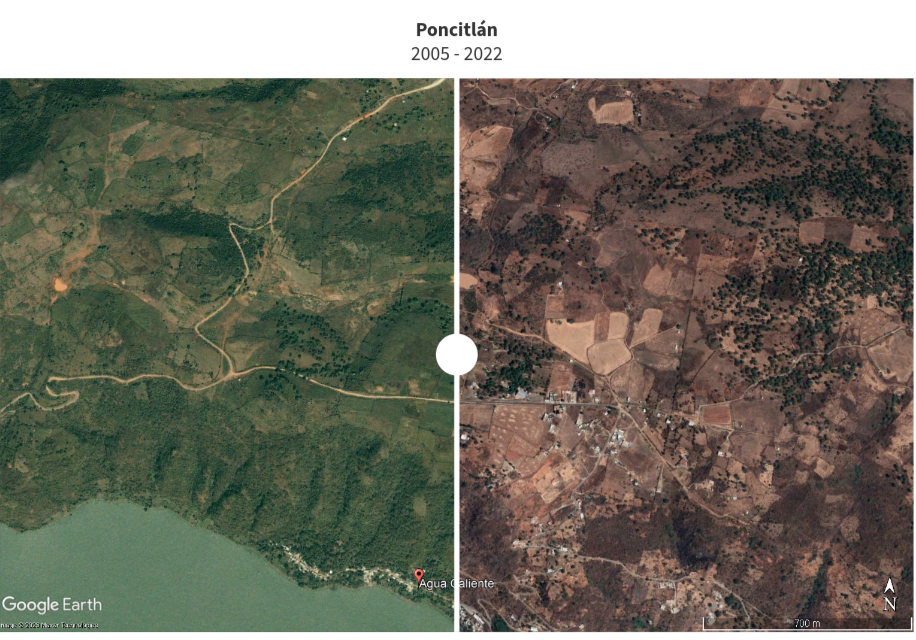
The current Mexican rural panorama can be explained from a historical perspective. In Mexico, technologies such as pesticides were introduced in the 1940s to increase productivity in the agricultural industry, following the Green Revolution. But their use did not spread widely in the country until the 1980s.
“When we grew up, we didn’t use the planting machine, fertilizers, or fumigation,” says Carmen. “My father always took us out, and we had to pull out all the grass, everything that the cornfield had growing in it.” She also remembers when her dad started using compost in the 1990s because other members of the community spread the word that it increased yields.
With the beginning of the North American Free Trade Agreement (NAFTA), agricultural dynamics changed. “Production was increasingly directed toward industrial scales, based on the North American model inherited from the Green Revolution, to the detriment of small production units intended for self-consumption, while the import of foreign corn continued to increase,” says researcher Fleur Gouttefanjat in the article “Green Revolution, neoliberalism and transgenics in Mexico: towards a subordination of corn to capital.”
After decades of sustained use of pesticides in the Mexican countryside, ecosystems have been negatively affected, including people and their health. But also, the use of transgenic seeds, genetically modified to be more efficient or resistant, generates dependence on the global seed market.
“Before, the seed was not bought; the corn itself was separated to be replanted,” Carmen recalls. Now, every year, they must buy seeds and pesticides. At least until they once again have their own seeds and other tools to nourish the soil. The garden can be a step to develop more agroecological projects that don’t depend on agroindustrial transnationals.
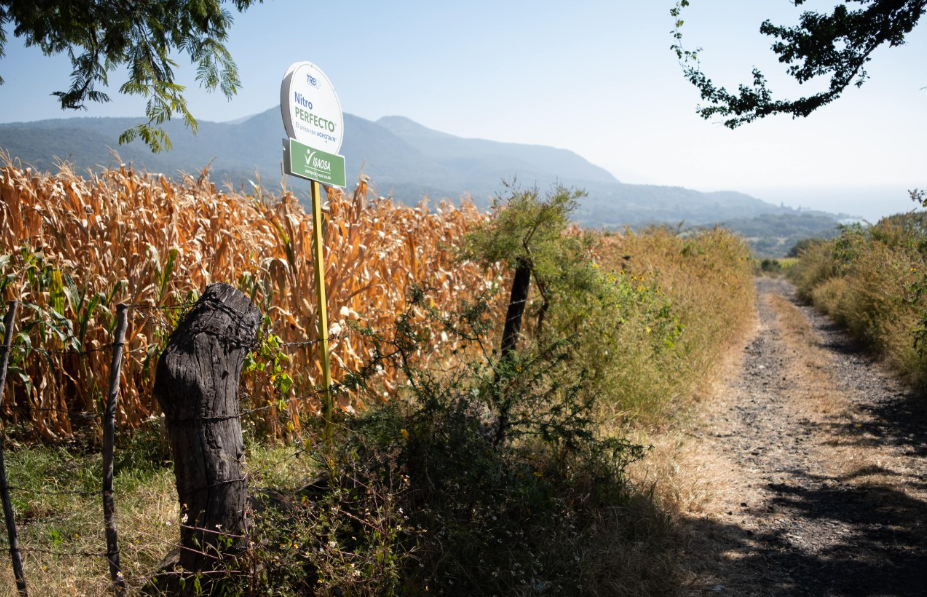
The argument of multicausality that dilutes responsibilities
Researchers who have studied kidney disease in the region identify a series of social and environmental determinants, such as water and air pollution, diet and malnutrition, agro-toxins, heavy metals, and poverty. However, the importance of each factor and how they relate to each other leaves gaps in the attribution of responsibility in the different levels of government.
“Ensuring that they have water of sufficient quality and quantity should be between CONAGUA (the National Water Commision) and the municipality, through the state,” says Carlos Peralta. This from a researcher who took the case of kidney disease in San Pedro Itzicán, a community adjacent to Agua Caliente, to the Latin American Water Tribunal (TLA). That is to say, articulating the levels of government to address a problem with as many aspects as access to water and its relationship with health can result in “everyone throwing their weight around.”
For its part, the Ministry of Health should carry out periodic monitoring of the chemical composition of the water to guarantee that it is suitable for human consumption, especially when it comes to wells drawing on thermal water that may have an excess of heavy metals. But the inaction of these institutions leaves the Agua Caliente community with precarious options to obtain water: the supply network that has constant failures, the contaminated lake, or hauling water from a thermal well.
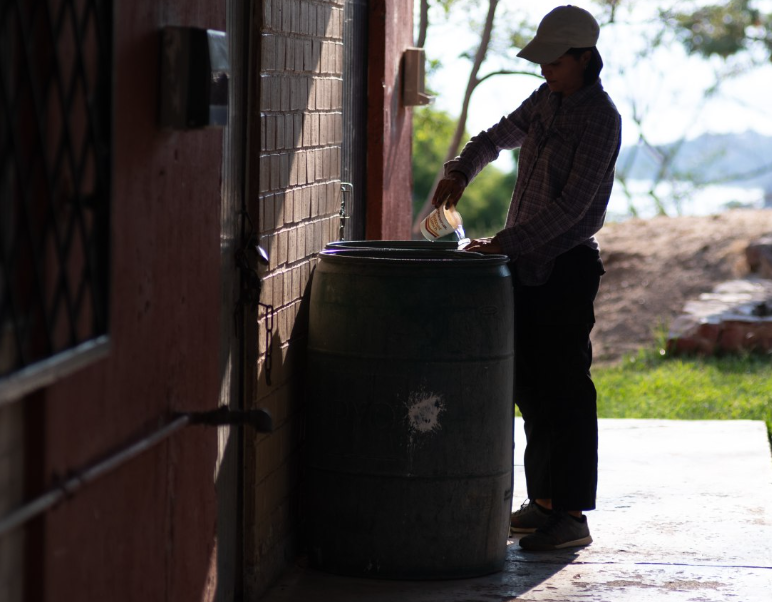
Confusion about the powers of different governmental bodies is fueled by the argument of multicausality. Responsibilities are diluted when there is resistance to attributing kidney disease to a specific factor. In the first place, “making the connection costs a lot of money,” explains Ana Sofía Macías.
Extensive studies would have to be carried out with representative samples: sampling of the lake, of the wells, of the water that reaches the houses. In addition, an epidemiological analysis would be needed that studies significant percentages of the population, provides concrete follow-up, and explains the health problem to the communities in terms that they understand.
“There is not enough political motivation to take on the damage that would be involved in making visible the impacts that this system has,” concludes the researcher.
The political empowerment of women
In this context, it was difficult for the women of the Escuelita Benita Galeana to gain the trust of the community. It was also difficult for the women of Agua Caliente to get involved in a project that, although it was not imposed from outside, implied a break in their daily lives.
“The women don’t know you, and they have a way of coexisting with projects or people from outside. They have identified that we are not a one-month or one-year project to obtain resources and leave,” reflects Flor López, who has addressed the technical issues of the garden.
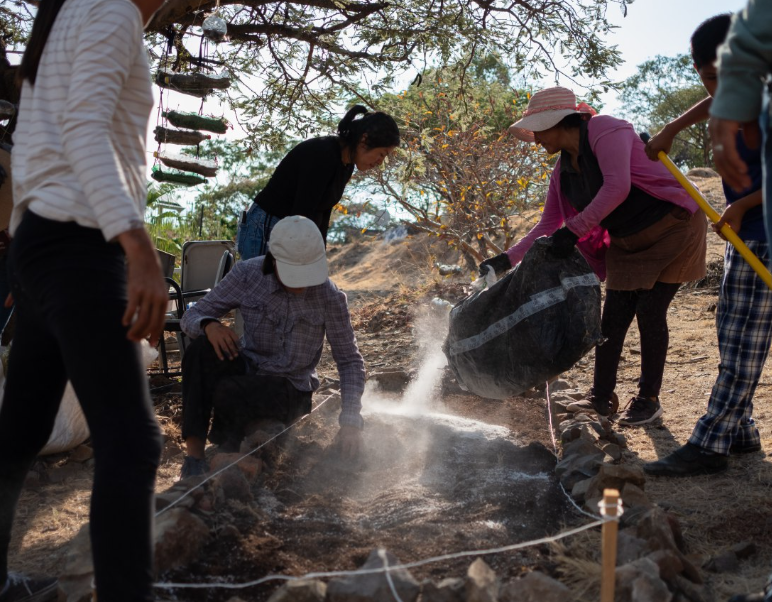
On the one hand, these communities are used to researchers and organizations coming to tell them what to do. Added to this is the structural violence to which they are exposed: the endless domestic work, the machismo that disapproves of them leaving their homes, the fact that there are no truly public spaces to meet, and the low wages that force them to leave the community to work on their own for weeks or months.
Given the multiple manifestations of the patriarchal system in which they are immersed, a central element of the Escuelita’s commitment is the political training of women.
“The work we do is to strengthen leadership so that the women, on their own, become women with rights,” says Carmen García.
Our hope is that the women will have food and will have their health. That is the dream we see: that the women become health promoters. That they have a health center where they can heal themselves — heal with these alternatives. That they know how to use herbal medicine. That the women stay organized and fight for their rights.
Carmen García
Co-founder of the Escuelita Benita Galeana
For the De Jesús Díaz sisters, the presence of the Network of Defenders has brought changes in how they perceive themselves. “I think that since we started participating in the Escuelita Benita Galeana there have been many changes,” Goya begins to share. She admits that it has been an uphill process and that she has had to break down sexist dynamics in her own family.
“I wasn’t free to go out even with my sister. That’s how difficult the situation was. Now I’m going to Tapalpa,” she laughs, remembering when she began to leave her community to go meet defenders in other territories.
Despite all these difficulties, in July 2023 the women of Agua Caliente began to realize what had been only a dream. Although not all of them had been involved at different times in the creation of the garden, one Monday afternoon eight women met to put the first plants in the ground. Their only wheelbarrow had a flat tire, and they had to carry bags of compost. They found some water in some drums that they used for irrigation. Under these conditions, they started the first planting bed with medicinal herbs (sage, lemon verbena, and wormwood) for the digestive system.
Unlike the hectares of agroindustrial crops that surround it, this garden is agroecological, that is, no chemicals are used to fertilize the plants or eradicate pests. The garden is just a first step.

Throughout this process, Goya has organically transformed herself into a community leader. Her tenacity and her empathy have given continuity to the project and strengthened the relationships among the women involved.
“Hurry up, we have to arrive on time — that’s where we challenge each other,” says Goya about how they motivate each other to not let the garden fail.
While they organize to carry water and compost, plow the land, and mix minerals that the soil lacks, the women of Agua Caliente are nurturing their territory and their network. Before leaving, they divide the days to go water at the school. It’s hard to find time during their busy days, but they work together to keep the small garden alive.
“There are few plants, and not all of us are there, but with two or three, we keep it together…” says Goya with a frank laugh.
***
This research was conducted with support from the Howard G. Buffet Fund for Women Journalists of the International Women’s Media Foundation (IWMF).

This article was originally published in Spanish on zonadocs.mx and is shared here with permission.
Mariana Mora / @rataquerueda and María Quinn / @mariaquinnc
Translation by Scott Powell / [email protected]
Agua Caliente Chapala Escuelita Benita Galeano Instituto Corazón de la Tierra Poncitlán